
Mosasaurs are an extinct group of large aquatic reptiles within the family Mosasauridae that lived during the Late Cretaceous. Their first fossil remains were discovered in a limestone quarry at Maastricht on the Meuse in 1764. They belong to the order Squamata, which includes lizards and snakes.
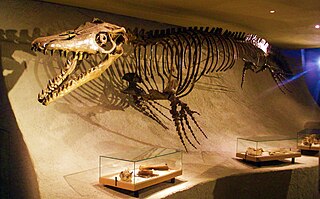
Mosasaurus is the type genus of the mosasaurs, an extinct group of aquatic squamate reptiles. It lived from about 82 to 66 million years ago during the Campanian and Maastrichtian stages of the Late Cretaceous. The genus was one of the first Mesozoic marine reptiles known to science—the first fossils of Mosasaurus were found as skulls in a chalk quarry near the Dutch city of Maastricht in the late 18th century, and were initially thought to be crocodiles or whales. One skull discovered around 1780 was famously nicknamed the "great animal of Maastricht". In 1808, naturalist Georges Cuvier concluded that it belonged to a giant marine lizard with similarities to monitor lizards but otherwise unlike any known living animal. This concept was revolutionary at the time and helped support the then-developing ideas of extinction. Cuvier did not designate a scientific name for the animal; this was done by William Daniel Conybeare in 1822 when he named it Mosasaurus in reference to its origin in fossil deposits near the Meuse River. The exact affinities of Mosasaurus as a squamate remain controversial, and scientists continue to debate whether its closest living relatives are monitor lizards or snakes.
Tylosaurus is a genus of mosasaur, a large, predatory marine reptile closely related to modern monitor lizards and snakes, from the Late Cretaceous.
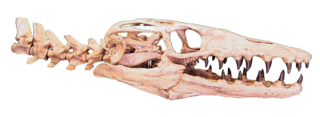
Selmasaurus is an extinct genus of marine lizard belonging to the mosasaur family. It is classified as part of the Plioplatecarpinae subfamily alongside genera like Angolasaurus and Platecarpus. Two species are known, S. russelli and S. johnsoni; both are exclusively known from Santonian deposits in the United States.

The Tylosaurinae are a subfamily of mosasaurs, a diverse group of Late Cretaceous marine squamates. Members of the subfamily are informally and collectively known as "tylosaurines" and have been recovered from every continent except for South America. The subfamily includes the genera Tylosaurus, Taniwhasaurus, and Kaikaifilu, although some scientists argue that only Tylosaurus and Taniwhasaurus should be included.
Plioplatecarpinae is a subfamily of mosasaurs, a diverse group of Late Cretaceous marine squamates. Members of the subfamily are informally and collectively known as "plioplatecarpines" and have been recovered from all continents, though the occurrences in Australia remain questionable. The subfamily includes the genera Latoplatecarpus, Platecarpus, Plioplatecarpus and Plesioplatecarpus.
Eonatator is an extinct genus of marine lizard belonging to the mosasaur family. It is a close relative of Halisaurus, and part of the same subfamily, the Halisaurinae. It is known from the Late Cretaceous of North America, Colombia and Sweden. Originally, this taxon was included within Halisaurus, but was placed in its own genus, which also led to the subfamily Halisaurinae being created for the two genera.
Platecarpus is an extinct genus of aquatic lizards belonging to the mosasaur family, living around 84–81 million years ago during the middle Santonian to early Campanian, of the Late Cretaceous period. Fossils have been found in the United States and possible specimens in Belgium and Africa. A well-preserved specimen of Platecarpus shows that it fed on moderate-sized fish, and it has been hypothesized to have fed on squid, and ammonites as well. Like other mosasaurs, it was initially thought to have swum in an eel-like fashion, although another study suggests that it swam more like modern sharks. An exceptionally well-preserved specimen of P. tympaniticus known as LACM 128319 shows skin impressions, pigments around the nostrils, bronchial tubes, and the presence of a high-profile tail fluke, showing that it and other mosasaurs did not necessarily have an eel-like swimming method, but were more powerful, fast swimmers. It is held in the Natural History Museum of Los Angeles County. Isotopic analysis on teeth specimens has suggested that this genus and Clidastes may have entered freshwater occasionally, just like modern sea snakes.
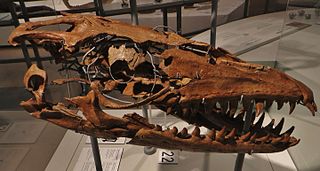
Prognathodon is an extinct genus of marine lizard belonging to the mosasaur family. It is classified as part of the Mosasaurinae subfamily, alongside genera like Mosasaurus and Clidastes. Prognathodon has been recovered from deposits ranging in age from the Campanian to the Maastrichtian in the Middle East, Europe, New Zealand, and North America.
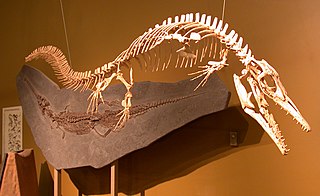
Halisaurus is an extinct genus of marine reptile belonging to the mosasaur family. The holotype, consisting of an angular and a basicranium fragment discovered near Hornerstown, New Jersey, already revealed a relatively unique combination of features and prompted a new genus to be described. It was named by Othniel Charles Marsh in 1869 and means "ocean lizard". It was renamed by Marsh to Baptosaurus in 1870, since he believed the name to already be preoccupied by the fish Halosaurus. According to modern rules, a difference of a letter is enough and the substitute name is unneeded, making "Baptosaurus" a junior synonym.
Clidastes is an extinct genus of marine lizard belonging to the mosasaur family. It is classified as part of the Mosasaurinae subfamily, alongside genera like Mosasaurus and Prognathodon. Clidastes is known from deposits ranging in age from the Coniacian to the early Campanian in the United States.

Dolichorhynchops is an extinct genus of polycotylid plesiosaur from the Late Cretaceous of North America, containing the species D. osborni and D. herschelensis, with two previous species having been assigned to new genera. Specimens of D. osborni have been found in the early Coniacian to early Campanian rocks, while those of D. herschelensis have been found in the late Campanian to early Maastrichtian rocks. Dolichorhynchops was a prehistoric marine reptile. Its Greek generic name means "long-nosed face". While typically measuring about 3 metres (9.8 ft) in length, the largest specimen of D. osborni is estimated to have a total body length more than approximately 4.3 metres (14 ft).
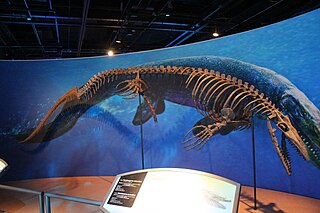
Taniwhasaurus is an extinct genus of mosasaurs that lived during the Campanian stage of the Late Cretaceous. It is a member of the subfamily Tylosaurinae, a lineage of mosasaurs characterized by a long toothless conical rostrum. Two valid species are attached to the genus, T. oweni and T. antarcticus, known respectively from the fossil record of present-day New Zealand and Antarctica. Two other species have been nominally classified within the genus, T. 'capensis' and T. 'mikasaensis', recorded in present-day South Africa and Japan, but their attribution remains problematic due to the fragmentary state of their fossils. The generic name literally means "taniwha lizard", referring to a supernatural aquatic creature from Māori mythology.
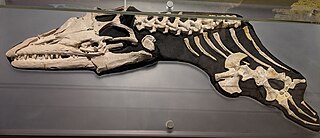
Angolasaurus is an extinct genus of mosasaur. Definite remains from this genus have been recovered from the Turonian and Coniacian of Angola, and possibly the Coniacian of the United States, the Turonian of Brazil, and the Maastrichtian of Niger. While at one point considered a species of Platecarpus, recent phylogenetic analyses have placed it between the (then) plioplatecarpines Ectenosaurus and Selmasaurus, maintaining a basal position within the plioplatecarpinae.

During the time of the deposition of the Niobrara Chalk, much life inhabited the seas of the Western Interior Seaway. By this time in the Late Cretaceous many new lifeforms appeared such as mosasaurs, which were to be some of the last of the aquatic lifeforms to evolve before the end of the Mesozoic. Life of the Niobrara Chalk is comparable to that of the Dakota Formation, although the Dakota Formation, which was deposited during the Cenomanian, predates the chalk by about 10 million years.

Plesioplatecarpus is an extinct genus of plioplatecarpine mosasaur known from the Late Cretaceous of the northern Gulf of Mexico and the Western Interior Basin of North America.

Paleontology in Kansas refers to paleontological research occurring within or conducted by people from the U.S. state of Kansas. Kansas has been the source of some of the most spectacular fossil discoveries in US history. The fossil record of Kansas spans from the Cambrian to the Pleistocene. From the Cambrian to the Devonian, Kansas was covered by a shallow sea. During the ensuing Carboniferous the local sea level began to rise and fall. When sea levels were low the state was home to richly vegetated deltaic swamps where early amphibians and reptiles lived. Seas expanded across most of the state again during the Permian, but on land the state was home to thousands of different insect species. The popular pterosaur Pteranodon is best known from this state. During the early part of the Cenozoic era Kansas became a savannah environment. Later, during the Ice Age, glaciers briefly entered the state, which was home to camels, mammoths, mastodons, and saber-teeth. Local fossils may have inspired Native Americans to regard some local hills as the homes of sacred spirit animals. Major scientific discoveries in Kansas included the pterosaur Pteranodon and a fossil of the fish Xiphactinus that died in the act of swallowing another fish.

Megacephalosaurus is an extinct genus of short-necked pliosaur that inhabited the Western Interior Seaway of North America about 94 to 93 million years ago during the Turonian stage of the Late Cretaceous, containing the single species M. eulerti. It is named after its large head, which is the largest of any plesiosaur in the continent and measures up to 1.75 meters (5.7 ft) in length. Megacephalosaurus was one of the largest marine reptiles of its time with an estimated length of 6–9 meters (20–30 ft). Its long snout and consistently sized teeth suggest that it preferred a diet of smaller-sized prey.

This timeline of mosasaur research is a chronologically ordered list of important fossil discoveries, controversies of interpretation, and taxonomic revisions of mosasaurs, a group of giant marine lizards that lived during the Late Cretaceous Epoch. Although mosasaurs went extinct millions of years before humans evolved, humans have coexisted with mosasaur fossils for millennia. Before the development of paleontology as a formal science, these remains would have been interpreted through a mythological lens. Myths about warfare between serpentine water monsters and aerial thunderbirds told by the Native Americans of the modern western United States may have been influenced by observations of mosasaur fossils and their co-occurrence with creatures like Pteranodon and Hesperornis.
This research history of Tylosaurus documents the historical developments in the study of Tylosaurus, a genus of extinct aquatic squamate reptile that lived during the Late Cretaceous.

















